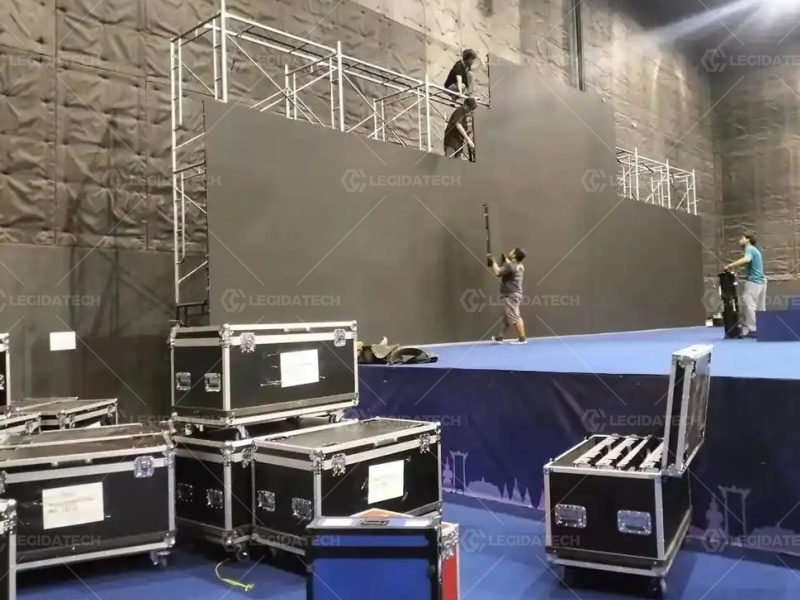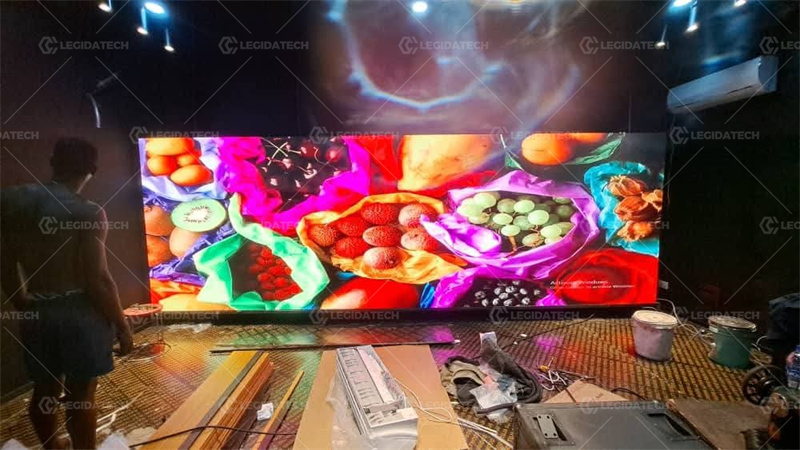Rental LED Screen Price
The price of a rental LED screen usually falls between USD 800 and 1,800 per square meter. Most rental screens use P2.6, P2.97, P3.91, or P4.81. These pixel pitches cover small indoor events to large outdoor shows.
Smaller pixel pitch means higher cost.
A P2.6 screen has more LEDs and a higher resolution than a P4.81 screen. So it costs more.
Outdoor rental screens cost more than indoor screens.
They need higher brightness and a fully waterproof design. Because of this extra protection, outdoor models are usually 20–40% more expensive than indoor models.
Different cabinet sizes also change the price.
The 500×500 mm cabinet is lighter and easier to set up.
The 500×1000 mm cabinet is heavier but cheaper per square meter because it uses fewer frames and takes less material.
Flight cases add cost but give better protection.
They keep the screens safe during transport and repeated rental use. For long-term rental businesses, flight cases help reduce damage and save money over time.
Indoor vs Outdoor Rental LED Screen Prices
| Type | Brightness | Protection Level | Usability | Cost Impact |
|---|---|---|---|---|
| Indoor Rental Screen | 800–1,200 nits | No waterproofing | Light, easy handling | Lower cost |
| Outdoor Rental Screen | 4,500–7,000 nits | IP65 waterproof | Heavier, more durable | 20–40% higher |
Indoor Rental Screens
Indoor screens do not need strong brightness. Most work well at 800–1,200 nits. They do not need a waterproof or windproof design.
They are light, easy to move, and quick to install. Because the structure is simple, the price stays lower.
Outdoor Rental Screens
Outdoor screens must fight sunlight.
They need 5,000–7,500 nits to stay bright in the daytime. And they also need IP65 protection against rain, dust, and wind. The outdoor LED advertising screens we see on the streets require even higher levels of protection.
The design is heavier, and setup takes more work. For the same pixel pitch, outdoor models are 20–40% more expensive than indoor ones.
Cabinet Size Impact on Price
| Cabinet Size | Weight | Setup Speed | Crew Requirement | Cost Impact |
|---|---|---|---|---|
| 500×500 mm | Lighter | High flexibility | 1–2 people per column | Slightly higher price |
| 500×1000 mm | Heavier | Faster for large screens | 2 people recommended | Slightly lower price |
500×500 mm Cabinets
These panels are light, compact, and easy for the crew to carry. Their smaller size makes setup and teardown faster, especially when the team works under time pressure.
Because you need more frames to cover the same screen area, the overall material use is higher, which makes the price per square meter slightly higher.
500×1000 mm Cabinets
These panels are bigger and heavier, but you need far fewer of them to build the same display size.
With fewer frames, connectors, and modules involved, the material and labor cost per square meter drops.
This is why the 500×1000 mm cabinets are usually the more affordable option, even though they are less convenient to move.
Flight Cases’ Impact on Price
Flight cases are designed for long-distance travel and frequent event cycles. They shield the LED panels from shock, vibration, moisture, and accidental drops during transport.
While they increase the upfront cost, they prevent damage and save money in the long run by reducing repair needs.
For touring shows, stage events, and outdoor productions, having solid flight cases is not just helpful but often essential to keep the rental screens in safe working condition.
| Item | What It Does | When You Need It | Cost Impact | Benefit |
|---|---|---|---|---|
| Flight Case | Protects panels during transport | Touring, outdoor events | Adds cost per box | Fewer damages & longer lifespan |
| No Flight Case | Bare transport | Local, occasional events | Lower upfront cost | Higher damage risk |

Rental LED Screen Pixel Pitch Comparison
| Pixel Pitch | Viewing Clarity | Ideal Viewing Distance | Typical Events | Price Range (USD/㎡) |
|---|---|---|---|---|
| P4.81 | Basic clarity | 5–12 m | Small business events | $650–850 |
| P3.91 | Good detail, most popular | 4–10 m | Exhibitions, mall shows | $750–980 |
| P2.97 | High clarity | 3–8 m | Concert stages | $950–1,250 |
| P2.6 | Premium image | 2.5–6 m | High-end concerts | $1,150–1,450 |
Rental LED Screen FAQ
1. Why does P2.6 cost more than P4.81?
Smaller pixel pitch means more LEDs per square meter.
More LEDs require higher precision, better modules, and advanced control systems.
The result is higher cost but sharper images and closer viewing distances.
2. Why is the 500×1000 mm cabinet slightly cheaper per square meter than the 500×500 mm?
The larger cabinet covers more area per unit.
You need fewer frames and connectors for the same screen size.
Even though it’s heavier, the total material and assembly cost per square meter is lower.
3. How much more do outdoor rental screens cost compared to indoor?
Outdoor rental screens need higher brightness (5,000–7,500 nits) and IP65 waterproofing.
They are heavier and take longer to install.
On average, outdoor models cost 20–40% more than indoor screens of the same pixel pitch and size.
4. Are flight cases necessary? How much extra do they cost?
Flight cases protect screens during long-distance transport and frequent rentals.
They add some cost per square meter but prevent damage, reduce repair needs, and extend the panels’ lifespan.
For touring events and large outdoor shows, they are highly recommended.
5. Is handling and installation of modular rental screens complicated?
Modular rental screens are designed for repeated assembly.
Panels, modules, and cables can be swapped quickly.
Lightweight cabinets are easy to carry, but larger or outdoor setups require a skilled crew and proper rigging.
Overall, installation is manageable but must follow safety standards.
6. How long do rental LED screens last?
With proper use and maintenance, rental screens last 5–8 years.
High-quality LEDs, power supplies, and control systems help achieve a longer life.
Flight cases and careful handling further protect the panels.
7. Are maintenance and module replacement expensive?
Replacing individual modules or power supplies is cheaper than replacing the whole screen.
Rental screens are modular, so maintenance is straightforward.
Good-quality modules cost more upfront but reduce long-term repair costs.
8. Why are rental LED screens more expensive than standard outdoor screens?
Rental screens need to survive frequent transport, setup, and teardown.
They require modular design, reinforced frames, higher durability, and optional flight cases.
These extra features raise the cost but make rental screens suitable for repeated events and long-term use.




